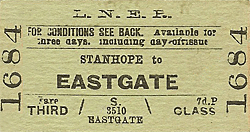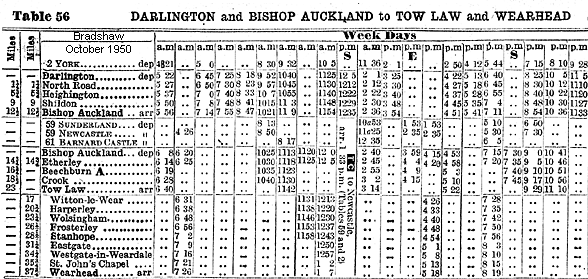|
Notes: The platforms were originally connected by a wooden
footbridge (see first picture), to be later replaced by a standard
North Eastern railway pattern type in 1920. Across the river
(back towards Frosterley) there was an engine shed, originally
built as a single road, extended to three roads and then later
in life cut back to single. During the Second World War, two
locomotives were stored in the shed for safekeeping. They were
Locomotion and Derwent from Darlington.
Despite losing the passenger traffic in 1953, the goods facility
continued until 1st November 1965 when all business was transferred
under the control of Bishop Auckland.
 In 1988 the newly refurbished platform opened
to accommodate an experimental Summer weekend service, which
was an extension of the Darlington to Bishop Auckland Heritage
Line service. Station improvements costing £9,000.00
were carried out prior to the introduction of the service,
being financed by contributions from Durham County Council
and the Heritage Line Group. In 1988 the newly refurbished platform opened
to accommodate an experimental Summer weekend service, which
was an extension of the Darlington to Bishop Auckland Heritage
Line service. Station improvements costing £9,000.00
were carried out prior to the introduction of the service,
being financed by contributions from Durham County Council
and the Heritage Line Group.
 |
The service was to prove an outstanding success and was repeated
each summer between 22nd May 1988 and 5th November 1989 and
Saturdays from 19th May 1991 to 27th September 1992
Wear Valley District Council bought the station building from
British Rail in 1992. Volunteers from the Weardale Railway Society
carried out some initial renovation work before the Council
took over and saw the project through to completion in early
1995.
BRIEF HISTORY OF THE WEAR VALLEY
RAILWAY (this is a shortened version taken from the Weardale
Railway Project web site. Click here for the full version)
It was in the early days of the Stockton & Darlington Railway
Company, that a railway to tap the mineral wealth of Weardale
was first considered. However, it wasn't until November 1843
when the Bishop Auckland & Weardale Railway was opened from
Shildon Junction to Crook that any real attempt was made to
penetrate the dale. The line was leased and worked by the Stockton
& Darlington Railway. An extension of this line in 1845
from Crook to Waskerley was opened to serve as another outlet
for the Derwent Iron Company at Consett. |
The section of line
was originally called the Weardale Extension Railway but later
under a merger with the line from Stanhope to Consett, was known
as the Wear & Derwent Junction Railway.
|
A plan to penetrate Weardale proper was covered by the
Wear Valley Act of July 1845, which was to provide a line
from Witton Junction (Wear Valley Junction) on the Bishop
Auckland & Weardale Railway to Frosterley, with a
connecting branch to Bishopley, this opened on 3rd August
1847..
In 1862 the Wear Valley line was extended to Stanhope
by the Frosterley & Stanhope Railway, mainly to reach
the Newlandside Estate on the south side of the town where
large quantities of limestone were known to exist.
The final extension of the Wear Valley line to Wearhead
was opened on 21st October 1895. It was impossible to
extend the line from the existing station at Stanhope
and a new station was built.
|
|
Between Eastgate and Westgate at Cambo
Keels, sidings were established to serve the Weardale Iron
Company's Heights limestone quarry. This quarry is still operational
today.
The passenger train service survived until 29th June 1953.
Up until closure, four trains per day had served the stations
of Witton-Le-Wear, Harperley, Wolsingham, Frosterley, Stanhope,
Eastgate, Westgate-in-Weardale, St. Johns Chapel and Wearhead.
The freight service to Wearhead survived until 1961 when the
line was cut back the St. John's Chapel. West of Eastgate followed
in 1968, which is the present terminus.
| Eastgate cement works were established in 1964 and brought
new life to the Wear valley line. Utilising purpose built container
wagons, cement was transported mainly by rail from the plant
to Teesside, Tyneside and Scotland. This operation ceased on
17th March 1993. The line which existed until 2004 was single
throughout between Eastgate and Shildon. There |
 |
There is a connecting
spur into Bishop Auckland station - the terminus of the
'Heritage Line' passenger service from Darlington.
A summer only Sunday passenger train service to Stanhope
operated as an extension to the Darlington service between
1988 & 1992. The success of this service was instrumental
in reopening the station at Etherley (renamed Witton Park),
in August 1991.
 |
A campaign to save the line west of Bishop Auckland, now known
as the Weardale Railway, began in 1993 with the threat of closure
and track uplift a real possibility after the last cement train
ran. Until 2004, the line was mothballed, but purchase by Weardale
Railways Limited has now been achieved and the first works trains
began running in 2004 in |
 |
in preparation for the reopening of the
first section between Stanhope and Wolsingham in July 2004.
In February 2005 Weardale Railways Ltd, the company operating
the line ran into financial difficulties and it was necessary
to call in an administrator. No service operated during 2005
but the Weardale Railway Project are hopeful of of a satisfactory
outcome in the near future with a resumption of services some
time in 2006.
See The
Weardale Railway Project web site. Tickets from Michael Stewart & Roy Lambeth
Click here
for Roy Lambeth's memories of the Wear Valley line in the late
1950's & 1960's
To see the other
stations on the Wear Valley Railway click on the station name:
Bishop Auckland,
Etherley, Wear
Valley Junction, Witton-le-Wear,
Harperley, Wolsingham,
Frosterley, Stanhope
(1st), Eastgate,
Westgate, St.
John's Chapel & Wearhead
|





20.jpg)
 In 1988 the newly refurbished platform opened
to accommodate an experimental Summer weekend service, which
was an extension of the Darlington to Bishop Auckland Heritage
Line service. Station improvements costing £9,000.00
were carried out prior to the introduction of the service,
being financed by contributions from Durham County Council
and the Heritage Line Group.
In 1988 the newly refurbished platform opened
to accommodate an experimental Summer weekend service, which
was an extension of the Darlington to Bishop Auckland Heritage
Line service. Station improvements costing £9,000.00
were carried out prior to the introduction of the service,
being financed by contributions from Durham County Council
and the Heritage Line Group. 
old5.jpg)




10.jpg)

 Home
Page
Home
Page